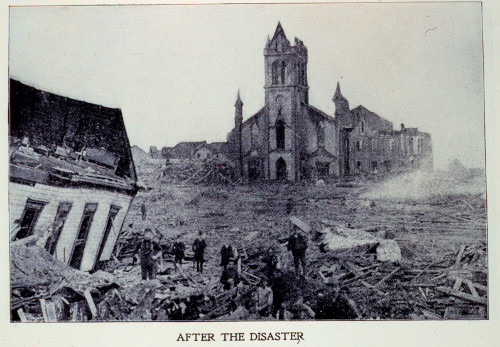
cross-referenced news and research resources about
Galveston Hurricane of 1900
The Hurricane of 1900 made landfall on September 8, 1900 in the city of Galveston, Texas, in the United States. It had estimated winds of 145 miles per hour (233 km/h) at landfall, making it a Category 4 storm on the Saffir–Simpson Hurricane Scale. It was the deadliest hurricane in US history, and the fourth costliest hurricane in US history based on the US dollar's 2005 value (to compare costs with those of Hurricane Katrina and others).
The hurricane caused great loss of life with the estimated death toll between 6,000 and 12,000 individuals; the number most cited in official reports is 8,000, giving the storm the third-highest number of deaths or injuries of any Atlantic hurricane, after the Great Hurricane of 1780 and 1998's Hurricane Mitch. The Galveston Hurricane of 1900 is the deadliest natural disaster ever to strike the United States. By contrast, the second-deadliest storm to strike the United States, the 1928 Okeechobee Hurricane, caused more than 2,500 deaths, and the deadliest storm of recent times, Hurricane Katrina, claimed the lives of approximately 1,800 people.
The hurricane occurred before the practice of assigning official code names to tropical storms was instituted, and thus it is commonly referred to under a variety of descriptive names. Typical names for the storm include the Galveston Hurricane of 1900, the Great Galveston Hurricane, and, especially in older documents, the Galveston Flood. It is often referred to by Galveston locals as The Great Storm or The 1900 Storm.
|

|

|
updated Sat. October 21, 2023
-
VVdailypress.com
April 2, 2018
Hughes' next book is based on the Great Galveston Hurricane that struck the Texas town on September 8, 1900. With winds up to 145 mph, the storm killed 6,000 to 12,000 people and was known as the deadliest in U.S. history. “My great-grandfather took a train from Ardmore, Oklahoma, to Galveston inÃâà...
New York Times
March 23, 2018
Houston rose to prominence as the Gulf Coast's premier trading metropolis only after a hurricane laid waste to nearby Galveston, in 1900. But Houston, which is projected in about a decade to edge past Chicago as the third-largest city in the United States, has endured its own share of weather misfortune.
Houston Public Media
March 22, 2018
The former Fire Station No. 3 was built in 1903, just a few years after the devastating 1900 Galveston hurricane. It was the first fire station in the city to integrate. But, despite all that history, the station's been abandoned since the late 1980s. Now, the Galveston Firefighters Association is working with the city'sÃâà...
The Hill
March 19, 2018
This week, another nor'easter is brewing off the East Coast. Meteorologists will watch the storm develop with one of the newest National Oceanic and Atmospheric Administration (NOAA) satellites. The new Geostationary Operational Environmental Satellite, known as GOES-R, has been in orbit for over aÃâà...
Houstonia Magazine
March 8, 2018
The property's elevation has shielded it from destruction as the old house weathers storm after storm, beginning with the Great Galveston Hurricane in 1900. The home remained in the Kennedy family for seven more decades; in the mid '70s, it saw an extensive remodel and enlargement, including theÃâà...
Houstonia Magazine
March 5, 2018
The Seawall, of course, is the 10-mile concrete barrier that the islanders built to protect their home after the infamous 1900 Hurricane nearly wiped the city off the map. Since then, the mural-covered fortification has aged quite well, fulfilling its defensive purpose while concentrating a great deal of island funÃâà...
Dallas News (blog)
September 8, 2017
On Sept. 8, 1900, the powerful storm made landfall in Galveston. Residents had long feared the severe damage a strong hurricane could bring and petitioned for a seawall around the city. Dr. Isaac Cline, Galveston's chief meteorologist, wrote in The Galveston Daily News that a seawall was unnecessary,Ãâà...
Chicago Tribune
August 31, 2017
The 1900 Galveston hurricane, the subject of Erik Larson's book "Isaac's Storm," still stands as this nation's deadliest storm, responsible for as many as ... While both storms were of Category 4 strength at landfall, it was the unexpected 15- to 20-foot storm surge across Galveston Island, not flooding rains,Ãâà...
History
August 29, 2017
The deadliest natural disaster in American history remains the 1900 hurricane in the island city of Galveston, Texas. On September 8, a category four hurricane descended on the town, destroying more than 3,600 buildings with winds surpassing 135 miles per hour. Estimates of the death toll range fromÃâà...
|
news and opinion
|
|
|
1900 galveston
hurricanes:
1900 galveston
|
|